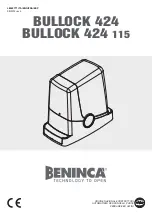
17
OPERATION AND CARE OR YOUR OPENER
OPERATION OF YOUR OPENER
Your opener can be activated by any of the following devices:
• Opener Control Panel:
UP & DOWN buttons, and
O.S.C. control button.
• Transmitter:
hold the button down until the door starts to
move.
• Wireless Entry Keypad:
This is an accessory that opens
the door using a four digit keycode.
When the opener is activated:
• If open, the door will close. If closed, the door will open.
• If closing, the door will stop.
• If opening, the door will stop (allowing space for entry and
exit of pets and for ventilation).
• If the door has been stopped in a partially open or closed
position, it will reverse direction.
Obstruction behaviour:
• If an obstruction is encountered while closing, the door
will reverse to the fully open position.
• If an obstruction is encountered while opening, the door
will stop and briefly reverse.
• The Protector SystemTM (IR Beams) use an invisible
beam which, when broken by an obstruction, causes a
closing door to open and prevents an open door from
closing. It is STRONGLY RECOMMENDED for
homeowners with young children or pets.
Opening the door manually:
The door can be opened manually by pulling the release cord
down firmly.
To re-engage the door, pull the release cord down firmly.
The opener lights will turn on under the following
conditions:
when the opener is initially plugged in; when power is restored
after interruption or when the opener is activated.
The opener
light will turn on for 3 minutes when the opener is
activated.
When releasing the door, the door should be
fully closed if possible. Weak or broken
springs could allow an open door to fall
rapidly. Property damage or serious injury
could result.
CARE OF YOUR OPENER
MAINTENANCE OR YOUR OPENER
When properly installed, your opener will operate with minimal
maintenance. The opener does not require additional
lubrication.
Limit and Force Settings:
These settings must be checked
and properly set when the opener is installed. Weather
conditions may cause some minor changes in the door
operation, requiring some re-adjustments, particularly during
the first year of operation. Refer to limit and force setting in
Section 14.
Follow the instructions carefully and repeat the safety
reverse test after any adjustment.
Transmitter:
Additional transmitters can be purchased at any
time. Refer to chamberlaindiy.com.au or chamberlaindiy.co.nz
for compatible transmitters. Any new transmitters must be
programmed into the opener.
Transmitter battery:
If the transmission range decreases,
replace the battery.
Once a Month:
• Repeat the safety reverse test (see Section 15). Make
any necessary adjustments.
• Manually operate the door. If it is unbalanced or binding,
call for professional garage door service.
• Check to be sure that the door opens and closes fully.
Set the limits and/or force if necessary.
SPECIFICATIONS WEATHERDRIVE (MR555MYQ)
Input Voltage:
Ratd Load:
Max. Pull Force:
Max. door weight:
Max. lift under spring tension:
Max. door area:
Drive:
Max. drum rotations:
Memory registers:
Operating frequency:
Operating temperature:
220-240 VAC, 50-60 Hz, 110 W
32 Nm
450 N @ O300 mm
100 kg
20 kg
16.5 m
2
DC gear motor permanent
lubrication
4
1
/
2
64
433.30/433.92/434.54 MHz
55
0
C to -25
0
C
SPECIAL NOTE: Merlin strongly recommends that The Protector System
TM
(IR Beams) be installed on all garage door
openers.








































